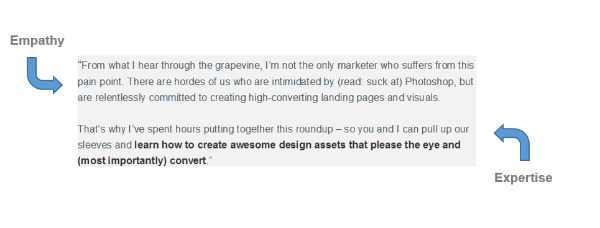How To Overcome Your Fears And Write The Perfect First Blog Post

Photo courtesy of Vic
You’ve read the statistics:
- Small businesses that blog generate up to 126% more leads than those who don’t.
- 77% of internet users read blogs.
- 61% of online US customers have made a purchase based on a blog.
- 69% of businesses say that their blogs are what gives them the most lead generation.
- 46% of people read blogs more than once a day
You know you should be doing it.
But something is holding you back from taking that first step.
What is it?
Oh yeah! Blogging is kind of terrifying.
And let me tell you some bad news that I’ve learnt from writing for a lot of different blogs over my career:
The first blog post never gets any easier.
And trust me, I would know – This is my first blog post at Spokal!
Whether you’re writing your first ever post, or just your first post for a specific blog/company, there’s a lot of pressure to get it just right.
But have no fear, help is here!
Here are some of the tips and tricks I’ve collected along the way that have helped me overcome my fears and writing the perfect first blog post!
1) Focus on your target audience

Photo courtesy of Coen Dijkman
This may seem obvious to some of you, but it can’t be emphasized enough.
Before you even start thinking of writing your first blog, get target audience-focused by doing some research.
This is where your competition comes in useful.
Scour the internet for blogs in your industry
Read through their posts. Read their comments sections. Check out their “most read” and “most commented” blogs.
By doing this, you can easily find answers to some of these crucial questions:
- What information does your target audience need?
- What information does your target audience want?
- What information is your target audience interested in right now?
- Is there something in your industry that hasn’t been written about yet?
After you get a good idea about what your target audience’s needs and desires are, you can move on to the next step: Thinking up an excellent topic idea!
2) Coming up with a topic
There are two types of beginner-writers: The self-conscious writerand the overly-confident writer.
We all lean towards one or the other.
But both types of writers deal with similar issues when it comes to generating a good topic to write about:
The temptation to settle on a mediocre idea.

Photo courtesy of Office.com
For the self-conscious writer, choosing a topic will be hard because they doubt their ability to come up with an excellent idea. This mean that they will write (hesitantly) about the first thing that they can think of that doesn’t seem too “stupid”.
Their first blog post is only mediocre because they often don’t push themselves to try harder or to take risks.

Photo courtesy of Office.com
The overly-confident writer, on the other hand, will take the first idea that pops into their head and not give anything else a second thought.
They think their idea is as good as it can get.
Unfortunately, their first blog post is equally as mediocre because they didn’t spend any time working on other options.
To create an excellent topic idea, you need to find the right balance between the two extremes.

Photo courtesy of Peddhapati
One of the most effective strategies that I’ve use to get this balance isbrainstorming.
It’s easy, it’s quick and it can be the difference between a mediocre post and an excellent one.
How to start a productive brainstorming session

Photo courtesy of Juliana Coutinho
- Sit down in a quiet room.
- Set a timer for between 15 – 20 minutes.
- Start writing topic ideas.
- Keep writing them until the time runs out.
- After your timer goes off, take three different colored markers/pens/crayons/paints/stickers (I’ll leave this up to you) and organize your ideas into good, mediocre and bad categories.
- Type up your good ideas in one word document and your mediocre ones in another document. (Ditch the bad ones and forget that they ever happened).
- Go through your “good ideas” list and choose your topic. (You’ll likely have realized what one you’re going to choose while you were writing and organizing your list).
Don’t scribble any ideas out if you think they’re “bad”. Don’t stopwhen you think you have the perfect one. Don’t linger on any idea for too long.
Let those creative juices flow, as messy as they may be.
The good ideas list will be your main focus. The mediocre list will be ideas that you can work on . The bad ideas list will be… well…
You don’t have a bad ideas list.
And guess what? By doing this you’ve also just come up with a list of potential topics to write about in the future too.
Feeling good?
Good.
That’s the point.
The exercise will build your confidence in your writing abilities by focusing on how many good ideas you can generate.
But if you don’t think this style will work for you, don’t worry. There are plenty of different ways to brainstorm topic ideas.
3) Starting the writing process
Ok, so you know who you’re writing for.
You have the perfect topic.
Now what?
First, open up a word document.
Don’t write directly into the blogging platform you’ll be using (i.e. WordPress, Blogger etc.).
Why, you ask?
1. Blogging platforms can be unfamiliar and cluttered

Photo courtesy of Illustration by Andrew Joyner
Blogging platforms are full of lots of unfamiliar buttons and new thingy-ma-bobs that you don’t know how to use (and might never have to).
It’s been proven that excess clutter can be detrimental to your focus.
So start by using something you’re already familiar with, like Microsoft word. You can easily keep this screen clear of buttons that are likely to distract you while you write.
2. Blogging platforms might give you stage fright

Photo courtesy of Andrew E. Larsen
Being reminded that you’re going to be publishing the post for all to see, might be a little bit intimidating when writing your first few blog posts.
Not being relaxed will wreak havoc on the tone and style of your writing.
3. You might accidentally publish something that’s not ready

Photo courtesy of Office.com
This is truly my worst nightmare. And for the record, it has happened to me on more than one occasion.
You need to feel unselfconscious when you’re writing, and having the risk that you might accidentally publish something for the world to see before it’s ready… that’s just a recipe for disaster.
Writing it in a word document means that you won’t have to worry about accidentaly publishing your post before it’s time.
“Ok, I have my word document opened. Now?”
Write your topic sentence first
What will you be saying in this blog? Why are you writing about it? Why is it important? Why should people read this?
Answer these questions by creating a topic sentence before you dive into the nitty-gritty of your blog. Writing a description of what you want to say or do in your blog before you write up the outline of your article will help you focus as you write.
And don’t worry if you need to change the topic sentence as your ideas and blog develop while you write, that’s all part of the process.
Write the outline of your post second
To make your blog especially juicy, the outline of your essay should always follow the same formula of introduction, body and conclusion.
I like to think of the introduction as the top bun of a burger because it’s the first thing that you see in a blog.
The body is the meat, vegetables and delicious condiments of your blog, because that’s where all the good stuff is.
The conclusion is the bottom bun because it’s important to keeping the whole thing together.

Photo courtesy of Sarah Burke
Introduction
Your introduction is really important to grab your reader’s attention.
Like with the top bun of a burger, it can either make your readers hungry for more or turn their stomachs.
The key to a great introduction to a blog post is the two “E’s” – Empathy and Expertise.
Empathy: Your readers want to know that you understand what they need.
Expertise: Your readers want to know that you know what you’re talking about.
Check out Unbounce’s perfectly polished two “E’s” in action:

Photo courtesy of Sarah Burke/Unbounce
See that? Now that makes me hungry for more!
Body

Photo courtesy of Jesslee Cuizon
The body is where you start talking about the topic of your blog in detail.
A good blog’s body should have at least three main headings, i.e. the meat, the lettuce and the ketchup.
For example, if you’re blog topic about “Why Dolphin’s Shouldn’t Be Kept In Captivity”, the three points in the body of your blog might be something like:
“The Psychology Of Dolphins”, “Captive Dolphins Versus Free Dolphins”and “What Changes Are Being Made for Dolphins in Captivity”.
Three main headings is the minimum I would recommend for a blog post, so feel free to add more.
Ideally, you should aim to write 1,500+ words per blog post. Longer posts generate more interest, with 68.1% more tweets and 22.6% more Facebook likes.
Conclusion
Writing a conclusion is the easy part, but it’s still very important to how successful your blog does.
First, sum up what you have said in your blog post.

Photo courtesy of Office.com
Second, create a call to action. This means asking your readers to leave a comment, share the blog, recommend other posts, share their stories etc.
This spreads the word of you and your business, so don’t underestimate its importance!
Some extra tips on the writing process
Don’t worry about writing garbage at first.
Remember that you’ll be editing everything, so don’t linger on errors, grammatical and spelling mistakes, factual omissions or missing hyperlinks in your first draft.

Photo courtesy of Office.com
The writing of your first draft is like, what Megan Ziman says over at Marketo, “barfing on paper”.
It’s not the finished product by any means and what’s important at this stage is to get the words out.
So spit them out.
You’ll clean it up later.
Write too much
Like I said, a lot of what you’re writing in your first draft is going to be edited anyways.
But by edit, I don’t just mean fixing grammar, rearranging headings, and spell checking.
When you edit your blog, you have to be prepared to delete a lot of stuff. This can be tough for new writers who feel like they’ve worked really hard to write it.
Writing too little or not enough may leave you tempted to keep some stuff just because you need it for word length.
This is death to an otherwise good first blog post.
Writing too much eases this temptation and ensures all the content is of the highest standard.
4) Edit your work. And then edit it some more. And then a little bit more.
Editing is what sets you apart from your competition. Giving up a first draft is like giving up a piece of scrap paper for a final exam.
Don’t do it.
First edit
Your first edit of the completed blog should concentrate on bulking up your points.
You’ve made a good argument, but has anyone else argued something similar? Or to the contrary?
Don’t be shy about linking to other blogs that either support or oppose your argument.
Add statistics, quotes, images and infographics to your piece.
This gives your blog more substance, and makes it authoritative.
Second edit
Read it out loud as if you’re addressing a crowded room.
Seriously.
I know, it might sound weird but I promise you, it works.
This will also be the point where you’ll see the most spelling and grammar errors, as well as syntax and tone mistakes. Reading aloud will reveal these to you as clear as daylight.
Third edit
Read over everything again and make changes were necessary.
Remember to keep your sentences short and to the point to the best of your abilities. (See what I did there???)
Fourth edit
Read over everything again and make changes were necessary.
Fifth edit
Read over everything again and make changes were necessary.
…You get what I’m getting at right?
Edit until you can read through your entire blog post without stopping to make any changes.
Writing your first blog post takes courage

Photo courtesy of Photo via Office.com
But it’s not impossible. All it takes is determination, hard-work and a lot of patience.
If you’ve tried any of the above tips, or have any other suggestions for new writers, feel free to share them with us in the comments section!!
Great post lots of good information. But to study more about your competitor is through their website. You can get ideas and learn more from it. Check out how: https://nobullmarketing.com.au/learn-from-competitor-websites/
ReplyDelete